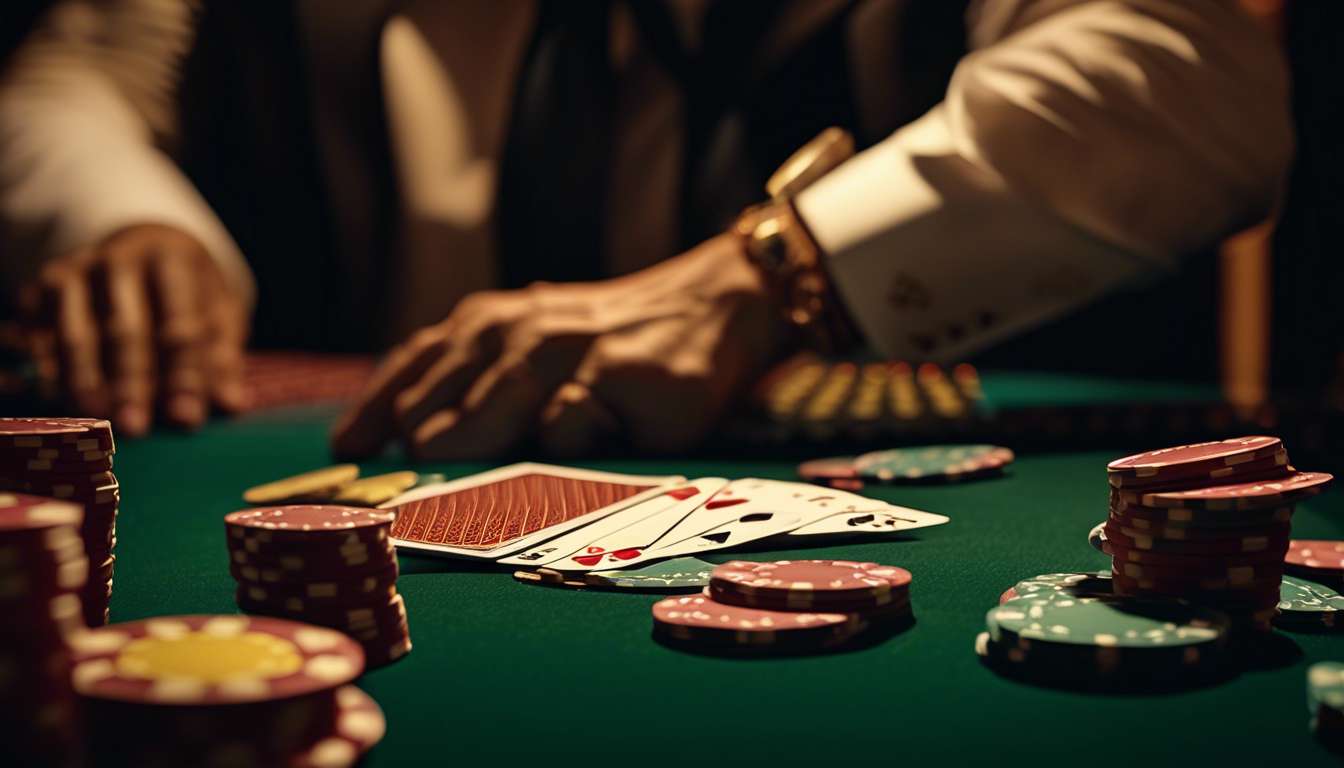Within casino gaming, we are often drawn to the allure of blackjack, a game that combines elements of skill and chance. Together, we embark on a journey to master the basic strategy of blackjack, understanding that this knowledge is our key to improving our odds and enhancing our gaming experience.
As a collective of enthusiasts, novices, and seasoned players alike, we recognize the importance of honing our skills to approach each hand with confidence and precision. Our shared goal is to demystify the complexities of decision-making at the blackjack table, transforming uncertainty into calculated moves that tilt the odds in our favor.
By delving into the fundamental principles of blackjack strategy, we equip ourselves with the tools necessary to:
- Make informed choices
- Minimize the house edge
- Ultimately, elevate our game
Let us explore these strategies together and embrace the thrill of outsmarting the game with knowledge and finesse.
Understanding Basic Blackjack Rules
Essential Rules of Blackjack
The primary goal in blackjack is to beat the dealer’s hand without exceeding a total of 21. Understanding this objective is crucial for making informed decisions during the game.
Gameplay Basics
-
Initial Deal:
- Each player is dealt two cards, face up.
- The dealer receives one card face up and one face down.
-
Player Decisions:
- Hit: Take another card to try and get closer to 21.
- Stand: Keep your current hand if you believe it can win.
- Double Down: Double your bet, take one additional card, and then stand.
- Split: If dealt a pair, split them into two separate hands to potentially increase your chances.
Shared Experience
By adhering to these foundational rules and strategies, players can enhance their gameplay. This makes blackjack not just a game of chance but a shared and strategic experience.
Importance of Card Values
Understanding card values is essential because they directly influence our decisions and strategies during each round of blackjack. As a community of blackjack enthusiasts, we know that each card holds a unique value that impacts our hand’s strength and, consequently, our next move. Mastering these values is a vital part of the blackjack basic strategy, ensuring we make informed choices rather than relying on sheer luck.
Card Values in Blackjack:
- Cards from 2 through 10 are worth their face value.
- Face cards—kings, queens, and jacks—are valued at 10.
- The ace is versatile, worth either 1 or 11, depending on which benefits our hand most.
This flexibility allows us to adapt and enhance our strategy. Recognizing the value of each card helps us calculate the total points in our hand and determine whether to:
- Hit
- Stand
- Double down
By understanding and applying card values, we strengthen our bond with fellow players, collectively raising our odds of success.
The Role of the Dealer’s Upcard
A key element in our blackjack strategy is understanding how the dealer’s upcard can dictate our next move. When we play as a team, we’re not just focusing on our own hand; we’re analyzing the dealer’s visible card to make informed decisions.
The dealer’s upcard is our ally, guiding us through the complexities of blackjack basic strategy. It tells us when to hit, stand, or surrender, depending on the strength of the dealer’s position.
- If the dealer shows a low card, like a 2 through 6, we know they’re more likely to bust. This insight encourages us to stand more often, conserving our strong positions.
- Conversely, a high upcard, such as a 7 through Ace, signals a potentially strong dealer hand, prompting us to take calculated risks by hitting or surrendering.
Together, by leveraging the dealer’s upcard, we enhance our collective chances of winning, fostering a sense of unity and shared success at the table.
Doubling Down and Splitting Pairs
Doubling Down and Splitting Pairs in Blackjack
Doubling down and splitting pairs are powerful moves that can significantly boost our potential winnings when used strategically. In the world of blackjack basic strategy, these tactics can mean the difference between a good night and a great one at the tables. We all want to feel like part of the in-crowd, especially when we’re making savvy moves that show we know our stuff.
Doubling Down
When we double down, we’re doubling our bet in exchange for just one additional card. It’s a bold move, typically used when:
- Our initial hand totals 9, 10, or 11.
- The dealer’s upcard is weak.
This is our chance to capitalize on a promising situation.
Splitting Pairs
Splitting pairs is another strategic gem. When we’re dealt two cards of the same value, splitting allows us to turn one hand into two, each with its own bet. This is particularly effective with:
- Aces
- Eights
Splitting these pairs gives us a better shot at increasing our odds and joining the ranks of skilled blackjack players.
Soft Hands vs. Hard Hands
Understanding the differences between soft hands and hard hands is crucial in refining our blackjack strategy and making informed decisions at the table.
When we hold a soft hand, which includes an ace valued as 11, we’ve got flexibility. For instance, a hand like Ace-6 can be 7 or 17, allowing us to hit without the risk of busting immediately. This adaptability is a key component of our blackjack basic strategy, letting us take calculated risks to improve our hand.
Conversely, hard hands don’t have this luxury. A hard hand lacks an ace or has an ace valued as 1. These hands, such as a 10-8, demand a more cautious approach since the chance of busting is higher.
By recognizing when we hold a soft versus a hard hand, we’re better equipped to make strategic moves that align with our collective goal of winning. Let’s continue honing these skills together, strengthening our shared understanding of blackjack.
Surrendering in Strategic Situations
In some challenging blackjack scenarios, surrendering can be a smart move to minimize our losses and conserve our bankroll for future hands. When we use surrender as part of our blackjack basic strategy, we’re not admitting defeat; rather, we’re playing wisely by recognizing when the odds are stacked against us. This awareness helps us feel more in control and connected with fellow players who understand the subtle art of strategic play.
Surrendering involves forfeiting half our bet and folding our hand before the dealer completes theirs, which is only available in certain games. We should consider surrendering in the following situations:
- When we hold a hard 16 against a dealer’s 9, 10, or Ace
- When we hold a hard 15 against a dealer’s 10
It’s a calculated decision that aligns with the principles of blackjack basic strategy to enhance our odds over time.
By incorporating surrender into our strategic toolkit, we’re optimizing our approach and fostering a sense of camaraderie with others who seek mastery in the game.
Countering Common Mistakes
Many players stumble by making preventable errors, but by identifying these common mistakes, we can significantly improve our game.
One major pitfall is ignoring the blackjack basic strategy. We sometimes let emotions drive our decisions, leading us to deviate from the tried-and-true strategy that gives us the best odds.
- Let’s resist the temptation to follow hunches or superstitions and stick to the strategy.
Another common error is misunderstanding the dealer’s upcard. We might hit when we should stand or vice versa, simply because we don’t fully grasp how their card influences our moves.
- By committing to the blackjack basic strategy, we gain a deeper understanding of these scenarios and make better choices.
Lastly, we often forget to manage our bankroll wisely. It’s easy to get swept up in the excitement, but by setting limits and sticking to them, we ensure our longevity at the table.
Together, we can counter these mistakes and elevate our blackjack game to new heights.
Practice Makes Perfect
Consistent practice is our key to mastering the nuances of blackjack and refining our strategic decisions. As a community of aspiring blackjack players, we understand that practice isn’t just about playing more hands; it’s about playing them with intention and a focus on our blackjack basic strategy. By dedicating time to practice, we reinforce our understanding of when to hit, stand, double down, or split, making these decisions instinctive over time.
Let’s embrace the power of practice by setting achievable goals. We can start by:
- Practicing with friends
- Using online simulators that allow us to make mistakes without financial consequences
In doing so, we build camaraderie and learn from each other’s experiences, strengthening our bond and strategic prowess.
Practicing together ensures we’re all equipped to face the unpredictable nature of blackjack. Let’s remember that each session brings us closer to mastery. With every practice hand, we’re not just improving our skills; we’re building a shared journey towards success.
How does card counting affect basic strategy decisions in Blackjack?
Card counting in Blackjack enhances basic strategy by providing insights into the probabilities of certain cards being dealt.
By keeping track of high and low cards, players can adjust their playing decisions to maximize their chances of winning. This extra layer of information complements existing strategy and offers an edge over the house.
Key adjustments in decision-making might include:
-
Betting Strategy: Increasing bets when the count is favorable, indicating a higher probability of high-value cards being dealt.
-
Playing Strategy:
- Standing on lower totals if the count suggests a high likelihood of busting.
- Hitting more aggressively if the deck is rich in low cards.
By integrating card counting with basic strategy, players can strategically modify their actions to improve their odds against the house.
What are the psychological factors that can influence a player’s adherence to basic strategy?
When we play Blackjack, various psychological factors can impact how well we stick to basic strategy.
Emotions such as:
- Fear
- Excitement
- Frustration
can lead us to make impulsive decisions instead of following the optimal plays.
Social influences like:
- Peer pressure
- A desire to showcase our skills
might also sway us from the best course of action.
Understanding and managing these influences can help us stay disciplined and improve our overall gameplay.
How do variations in Blackjack rules across different casinos impact basic strategy?
Variations in Blackjack Rules
Blackjack rules can vary significantly from one casino to another, and these differences can greatly impact basic strategy.
Importance of Adaptability
It’s essential to stay informed and adaptable when navigating these differences. A flexible approach allows us to maximize our chances of success, regardless of where we play.
Understanding Rule Variations
By understanding how rule variations influence our strategy, we can confidently make the best decisions at any table we encounter.
Keys to Success
- Stay sharp.
- Be prepared for anything.
Adhering to these principles ensures that we can effectively navigate the nuances of each casino’s rules and maintain a strategic edge.
Conclusion
Mastering Blackjack Basic Strategy
You’ve now grasped the fundamentals of mastering blackjack basic strategy for improved odds. By understanding the following concepts, you’re well on your way to success:
-
Rules and Card Values: Familiarize yourself with the game rules and the values of the cards.
-
Dealer’s Upcard Influence: Learn how the dealer’s visible card affects your decision-making.
-
Doubling Down: Know when to double your bet for potentially higher returns.
-
Splitting Pairs: Identify opportunities to split pairs for a strategic advantage.
-
Soft vs. Hard Hands: Differentiate between soft and hard hands to optimize your play.
-
Strategic Surrendering: Recognize situations where surrendering can minimize losses.
Avoid Common Mistakes
- Misjudging hand values
- Ignoring the dealer’s upcard
- Mismanaging your bankroll
Practice is Key
Keep honing your skills through practice. Soon, you’ll be confidently playing blackjack with a strategic edge.
Good Luck at the Tables!

